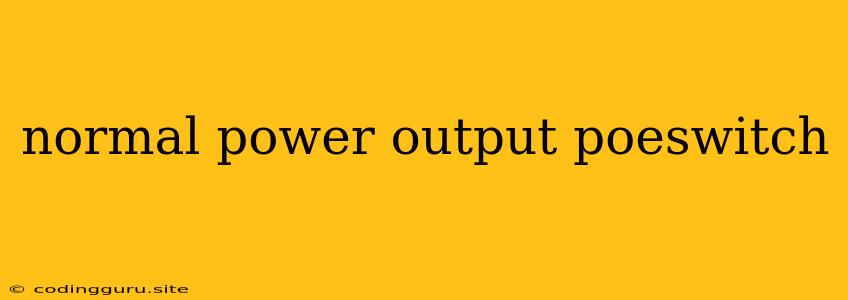Understanding and Troubleshooting Power Output on PoE Switches
Power over Ethernet (PoE) has revolutionized network infrastructure by enabling devices to draw power directly from the network cable, eliminating the need for separate power adapters. This convenience comes with its own set of considerations, particularly when it comes to the power output of the PoE switch.
What is Normal Power Output on a PoE Switch?
The power output of a PoE switch is determined by its PoE standard compliance. The most common standards are:
- IEEE 802.3af: This standard provides a maximum power output of 15.4 watts per port.
- IEEE 802.3at (PoE+): This standard offers a higher power output, reaching up to 30 watts per port.
- IEEE 802.3bt (PoE++): This latest standard boasts a significantly higher power output, delivering up to 90 watts per port.
How to Determine Your PoE Switch's Power Output:
- Check the switch's specifications: The PoE switch's datasheet or user manual will clearly state the power output capabilities of each port.
- Look for PoE labels: Many PoE switches have labels on their ports indicating the PoE standard they support.
- Use a PoE tester: A PoE tester can measure the voltage and current delivered by a PoE switch, providing accurate information about the power output.
Troubleshooting Low Power Output:
- Check the device compatibility: Ensure the device you are connecting to the PoE switch is compatible with the PoE standard supported by the switch.
- Verify power settings: Some PoE switches allow you to adjust the power output per port. Check the configuration and make sure the settings are optimal for your device.
- Inspect the cable: A faulty or damaged cable can hinder power delivery. Make sure the PoE cable is properly connected and in good condition.
- Examine the port: If a PoE port is malfunctioning, it might be delivering less power output. Try connecting the device to a different port on the switch.
Important Considerations:
- PoE budget: Each PoE switch has a limited total power output capacity. This is known as the PoE budget. Make sure the combined power requirements of all connected devices are within the switch's PoE budget.
- Power consumption: The power output of a PoE switch needs to be sufficient to meet the power consumption requirements of the device. Check the device's specifications for its power consumption.
- PoE injector: If the PoE switch doesn't provide enough power output, a PoE injector can be used to supply additional power to the device.
Understanding the 'POE Switch' and its 'Normal Power Output' is Crucial:
- Efficient Network Management: Knowing the PoE switch's normal power output allows you to select compatible devices and avoid overloading the switch.
- Avoiding Equipment Failure: Insufficient power output can cause devices to malfunction or fail altogether. Ensuring adequate power output is crucial for reliable network operation.
- Optimizing Power Consumption: Understanding the PoE switch's power output helps you optimize power consumption and reduce energy waste.
Conclusion:
The normal power output of a PoE switch is a crucial factor in network performance and device reliability. Understanding the different PoE standards and their respective power output capabilities is essential for choosing the right PoE switch for your needs. By checking the switch's specifications, verifying device compatibility, and troubleshooting potential power issues, you can ensure your network operates efficiently and reliably.
